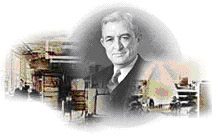Carrier: The World Leader in Air Conditioning, Heating and Refrigeration Sytems
The history of air conditioning is a history of Carrier, and there's more behind the comfort we take for granted on a sweltering summer day than you might think.
 When Willis Carrier designed his first air conditioning system in 1902, his customer was a frustrated Brooklyn, N.Y. printer who couldn't print a decent color image because changes in heat and humidity kept changing the paper's dimensions and misaligning the colored inks. When Willis Carrier designed his first air conditioning system in 1902, his customer was a frustrated Brooklyn, N.Y. printer who couldn't print a decent color image because changes in heat and humidity kept changing the paper's dimensions and misaligning the colored inks.
For nearly two decades, Carrier's invention that allowed us to scientifically control the temperature and humidity of our indoor environment was meant for the comfort of machines or industrial processes rather than people. It wasn't until 1906 that Carrier, then employed by the Buffalo Forge Company, patented his first device — "An Apparatus for Treating Air."
Southern U.S. textile mills were among the first users of Carrier's new system. A lack of moisture in the air of the Chronicle Cotton Mill in Belmont , N.C. created excess static electricity that made cotton fibers become fuzzy and hard to weave. Carrier's system raised and stabilized humidity levels to eliminate the "fuzzies." It conditioned the fibers. The first overseas sale of a Carrier system was made to a silk mill in Yokohama , Japan in 1907.
Razor blades, celluloid film, capsules for pharmaceuticals, processed tobacco, bakeries, meat packing houses, soap manufacturers, munitions . . . the list of industries that found they could improve their products by using "conditioned air" from Carrier expanded dramatically.
Encouraged by their success, Carrier and six friends scraped together $32,600 and formed the Carrier Engineering Company in 1915 — a company whose only product was a guarantee to achieve the temperature and humidity levels their customers required.
Carrier, the company, began manufacturing products in 1922 after the company's namesake developed one of the most significant achievements in the industry's history — the centrifugal refrigeration machine . The centrifugal chiller, or just plain centrifugal as many call it, was the first practical method of air conditioning large spaces. This single achievement paved the way for the upward expansion of cities as well as bringing human comfort to hospitals, schools office buildings, airports, hotels, and department stores.
Once again, though, the first machines were used to stabilize industrial processes like candy and pottery making.
Comfort cooling made its debut in 1924 at the J.L. Hudson Department Store in Detroit , Mich. Shoppers at the store's popular basement bargain sales fainted from the heat as huge crowds overpowered the ventilation system. The sales became even more popular as three Carrier centrifugal chillers were installed to cool the basement and soon the rest of the store.
Many Americans experienced air conditioning for the first time in theaters as owners struggled to revive summer business that always slumped as temperatures rose.
"The cooling plant is revolutionizing picture show attendance in Houston !" said Will Horowitz, Jr., the Texas theater owner who asked Carrier to air condition The Palace, the Texan and the Iris theaters in 1924. "Patrons exclaim with delight when they get inside the doorway."
As Willis Carrier said, though, the acid test came when the young company was asked to air condition the famed Rivoli Theater in New York . The Rivoli's "cool comfort" was heavily advertised and block-long lines formed early on Memorial Day 1925 — nearly every patron was carrying cardboard fans, just in case. The film that showed that night was soon forgotten, but not the appeal of air conditioning. Summer film business boomed and by 1930, the 300 theaters Carrier had air conditioned were showing Americans they no longer had to settle for stifling indoor environments.
Owners of smaller businesses wanted to compete with larger retailers so Carrier began developing smaller "unit air conditioners" in the late 1920s. It was a small step in 1928 to the development of a residential "Weathermaker" that heated, cooled, humidified, cleaned and circulated air in homes, but the Great Depression quickly put an end to residential air conditioning.
Carrier's "unique" igloo in the 1939 World's Fair attempted to give visitors a vision of how their futures and air conditionings futures would mingle, but it was not until after World War II that sales of these smaller units for businesses and homes began increasing again.
|
